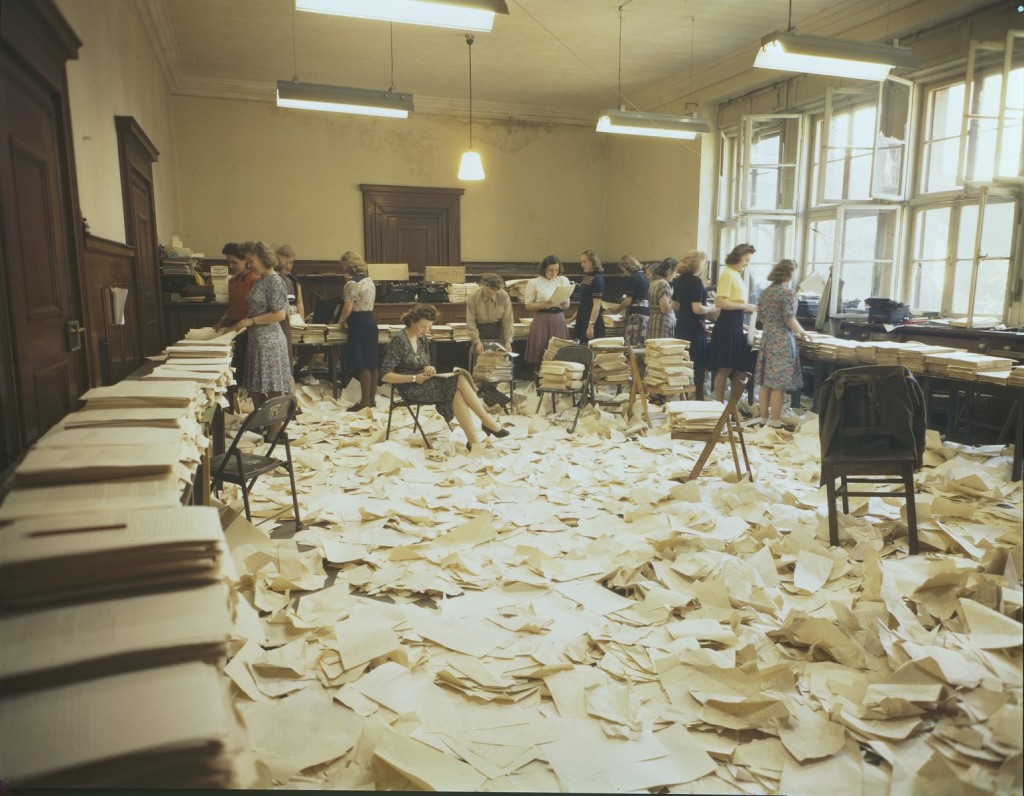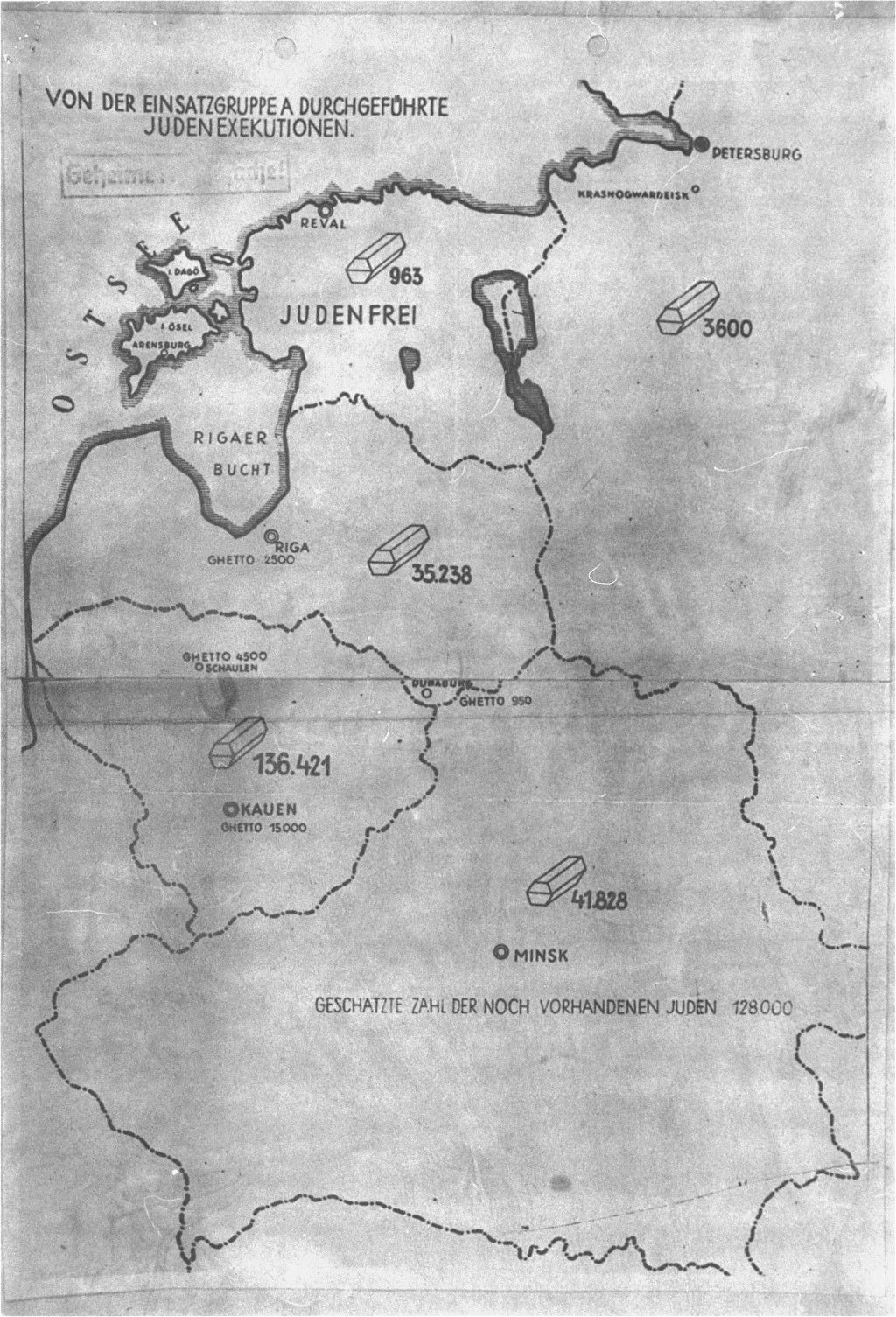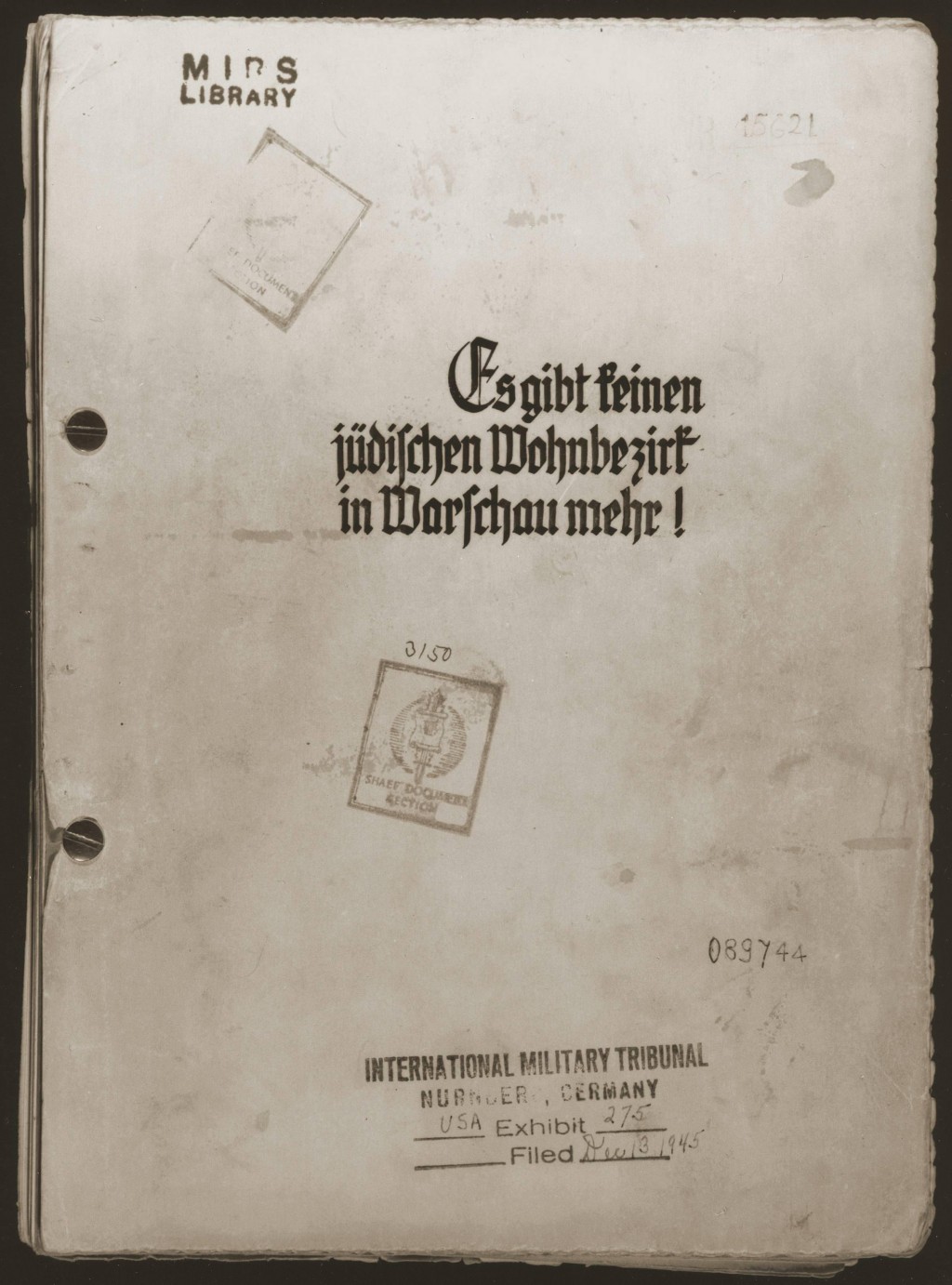
Combating Holocaust Denial: Evidence of the Holocaust presented at Nuremberg
The Holocaust is the best documented case of genocide. During the trials held in Nuremberg after the war, Allied prosecutors submitted thousands of German documents proving that the Nazi regime had carried out the systematic persecution and destruction of the Jewish people. This evidence included numerous photographs and films created by Nazi Germans. It also included eyewitness accounts by survivors and perpetrators.
Key Facts
-
1
The Nuremberg trial of the major Nazi war criminals exposed Nazi Germany’s plans for premeditated war against its European neighbors and its implementation of policies that led to the persecution and mass murder of Europe’s Jews.
-
2
In its case against the Nazi leadership, the prosecution assembled a mass of evidence, documents as well as personal testimony, on the Holocaust.
-
3
This evidence serves as conclusive proof of the Holocaust and a lasting refutation of those who attempt to deny it.
Background
The best known of the war crimes trials held after World War II was the trial of “major” German war criminals held in Nuremberg, Germany. Leading officials of the Nazi regime were tried before the International Military Tribunal (IMT) in the Palace of Justice in Nuremberg, before judges from Great Britain, France, the Soviet Union, and the United States. The IMT tried 22 Germans as major war criminals on charges of conspiracy, crimes against peace, war crimes, and crimes against humanity. In twelve subsequent proceedings, the United States tried 183 German leaders in Nuremberg.
But the Nuremberg trials did more than just try leading Nazi officials in government, the armed forces, and the economy. Their lasting legacy included the deliberate assembly of a public record of the horrific crimes, including those of the Holocaust, committed by Nazi Germany and its collaborators during World War II.
In his opening statement to the IMT on November 21, 1945, Justice Robert H. Jackson, Chief of Counsel for the United States, outlined the case against the Nazi leaders and the evidence he planned on introducing into the trial. He stated:
This Tribunal, while it is novel and experimental, is not the product of abstract speculations… We will not ask you to convict these men on the testimony of their foes. There is no count in the Indictment that cannot be proved by books and records…[these men] arranged frequently to be photographed in action. You will see their own conduct and hear their own voices as these defendants reenact for you some of the events in the course of the conspiracy.
—US Chief Prosecutor Robert H. Jackson
Opening statement before the International Military Tribunal
Listen to an excerpt
By using Nazi documents against the defendants, one of the prosecution’s goals was to prove that the Nazis had deliberately set out to destroy the Jewish people. They did this by assembling evidence that confirmed a Nazi plan to systematically murder Europe’s Jews. In his opening statement, Jackson further explained:
These crimes were organized and promoted by the [Nazi] Party leadership, executed and protected by the Nazi officials, as we shall convince you by written orders of the Secret State Police [Gestapo] itself... The conspiracy or common plan to exterminate the Jew...largely has succeeded. Only remnants of the European Jewish population remain in Germany, in the countries which Germany occupied, and in those which were her satellites or collaborators.
Nazi German Documents as Evidence
The American prosecutors at Nuremberg decided the best evidence against Nazi war criminals was the record left by the Nazi German state itself. They wanted to convict Nazi war criminals with their own words. While the Germans destroyed some of the historical record at the end of the war and some German records were destroyed during the Allied bombing of German cities, Allied armies captured millions of documents during the conquest of Germany in 1945. Allied prosecutors submitted tens of thousands of documents at the Nuremberg trials. More than a decade later, beginning in 1958, the United States National Archives, in collaboration with the American Historical Association, published 62 volumes of finding aids to the records captured by the US military at the end of the war. More than 30 further volumes were published before the end of the 20th century.
The US Army made many significant finds of Nazi booty and records, among them gold, currency, artworks, and documentation discovered on April 7, 1945, by engineers of the US 90th Infantry Division in the Kaiseroda Salt Mine in Merkers, Germany. Millions of documents were captured at various locations, including records of the German Army High Command records; files from Krupp, Henschel, and other German industrial concerns; Luftwaffe (German air force) material; and records kept by Heinrich Himmler (the Chief of the German Police and Reich Leader of the SS), the German Foreign Office, and many others.

Even where central files had been destroyed, the Allies were able to some extent to reconstruct events and operations from the records they did secure. The Reich Security Main Office (RSHA) records, for example, were burned in the basement of its Prague regional headquarters but copies of many RSHA records were found and collected from the files of local Gestapo (secret state police) offices across Germany.
Captured German documents, such as the Einsatzgruppen Reports, also provided a record of the policies and actions of the Nazi state. Einsatzgruppen (special action groups) were assigned among other tasks to kill Jewish civilians during the invasion of the Soviet Union in 1941. The Einsatzgruppen Reports, which documented their progress, were among the documents submitted at Nuremberg that were central to proving the Holocaust had occurred.
Among the most crucial documents submitted as evidence at Nuremberg was the Wannsee Conference Protocol. This document is one of the most important surviving German documents on the Holocaust. It comprises the carefully revised minutes of the Wannsee Conference (January 20, 1942), chaired by Reinhard Heydrich, at which he outlined the expansion of Nazi mass murder to encompass 11 million Jews in Europe. The Protocol was compiled, and heavily edited, by Adolf Eichmann from notes taken during the meeting. It identifies not only the participants at the conference, but their agreement to collaborate on a continental scale in the “Final Solution to the Jewish Question,” in other words, mass murder.
These are just a few examples of the types of documents collected and presented by the prosecution at Nuremberg.
Photographs and Film as Evidence
During the Nuremberg trial, Nazi Germany's dedicated filming of itself was also turned into evidence of its crimes. From the earliest beginnings of the Nazi Party in the 1920s, through the military invasions of World War II and graphic depictions of atrocities, German photographers and camera crews recorded (often proudly) what they accomplished in pursuit of their ideology. Toward the end of the war, teams of Allied military personnel worked tirelessly to locate, collect, and categorize this photographic and film record.
In addition to official photography and films produced at the order of the Nazi state, German soldiers and police took numerous photographs and film footage of German operations against Jews and other civilians. They documented the public humiliation of Jews, their deportation, mass murder, and confinement in concentration camps. This became powerful visual evidence of Nazi war crimes submitted at Nuremberg. Such photographic documentation came from all levels of the Nazi hierarchy.
For example, Allied prosecutors submitted as evidence to the IMT the so-called “Stroop Report,” a commemorative album from SS and Police Leader Jürgen Stroop to his superior Heinrich Himmler. The report documented Stroop’s brutal suppression of the Warsaw ghetto uprising in spring 1943. An appendix included an album of photographs taken on his orders. According to Stroop's own calculations, his forces captured more than 55,000 Jews. Of these, they killed at least 7,000 people and sent 7,000 more to the Treblinka killing center.

Further visual documentation came from the US Army Signal Corps, which, in the course of photographing and filming American operations in World War II, also played a crucial role in documenting evidence of Nazi atrocities and the Holocaust. Many of the early still and moving pictures of newly liberated Nazi concentration camps were taken by Army photographers such as Arnold E. Samuelson and J Malan Heslop. A number of these images were later transmitted to news agencies in the United States and other countries, where they helped to inform the world about the horrors of Nazism and the plight of concentration camp prisoners.
On November 29, 1945, the IMT prosecution introduced an hour-long film titled "The Nazi Concentration Camps." When the lights came up in the Palace of Justice all assembled sat in silence. The human impact of this visual evidence was a turning point in the Nuremberg trial. It brought the Holocaust into the courtroom.
Survivor and Perpetrator Eyewitness Testimony
Eyewitness testimony from both perpetrators and survivors laid the foundation for much of what we know about the Holocaust, including details of the Auschwitz death machinery, atrocities committed by the Einsatzgruppen and other SS and police units, the destruction of the Warsaw ghetto, and the original statistical estimate of six million murdered Jews. Many people directly involved in the killing program died before the end of the war, but the Allies interrogated many of those who were still alive in preparation for the trial. None of the perpetrators denied the Holocaust. Most just tried to deflect their responsibility for the killings.
Three key perpetrators gave evidence directly related to the Holocaust. Hermann Göring, the highest official of the Nazi state tried at Nuremberg, testified openly and frankly about the persecution of German Jews from the rise of the Nazi Party to power in 1933 until the outbreak of war in 1939. Otto Ohlendorf testified directly about his unit, Einsatzgruppe D, killing 90,000 Jews in southern Ukraine in 1941. And the long-time commandant of Auschwitz, Rudolf Hoess, testified frankly about the gassing of more than a million Jews at the Auschwitz-Birkenau killing center during the war. All three claimed that they carried out the legitimate orders of the state. The testimony of these and other perpetrators is often chilling in its frankness about the killing program.
Irrefutable Evidence of the Holocaust
The IMT’s findings and the fact that perpetrators themselves admitted that the “Final Solution” took place is irrefutable evidence of the Holocaust.
During the trial, the perpetrators themselves never said that the Holocaust did not happen. Rather, they tended to absolve themselves of individual guilt. Neither they nor their defense attorneys claimed that the mass murder of Europe’s Jews did not happen.
No less important are personal, immediate, and compelling testimonies of the Holocaust provided as evidence by survivors, who directly experienced Nazi genocidal policies. Survivors like Marie-Claude Vaillant-Couturier, who testified at Nuremberg about her experiences at Auschwitz, provided the human element to the trial proceedings. Such witnesses conveyed what it meant to be the target of genocide.
Taken together, the documents, photographs, film, and eyewitness testimonies at postwar trials, as well as thousands of hours of survivor testimony recorded since the IMT took place in 1945, provide undeniable documentation of the Holocaust.
Footnotes
-
Footnote reference1.
We will not ask you to convict these men on the testimony of their foes. There is no count in the Indictment that cannot be proved by books and records. The Germans were always meticulous record keepers, and these defendants had their share of a Teutonic passion for thoroughness in putting things on paper. Nor were they without vanity. They arranged frequently to be photographed in action. We will show you their own films. You will see their own conduct and hear their own voices as these defendants reenact for you some of the events in the course of the conspiracy.
Critical Thinking Questions
How and why do deniers of the Holocaust explain their beliefs in the face of the overwhelming mass of documentation and testimony?
Investigate the efforts to document mass atrocities since the Holocaust. What new types of evidence may be included?

